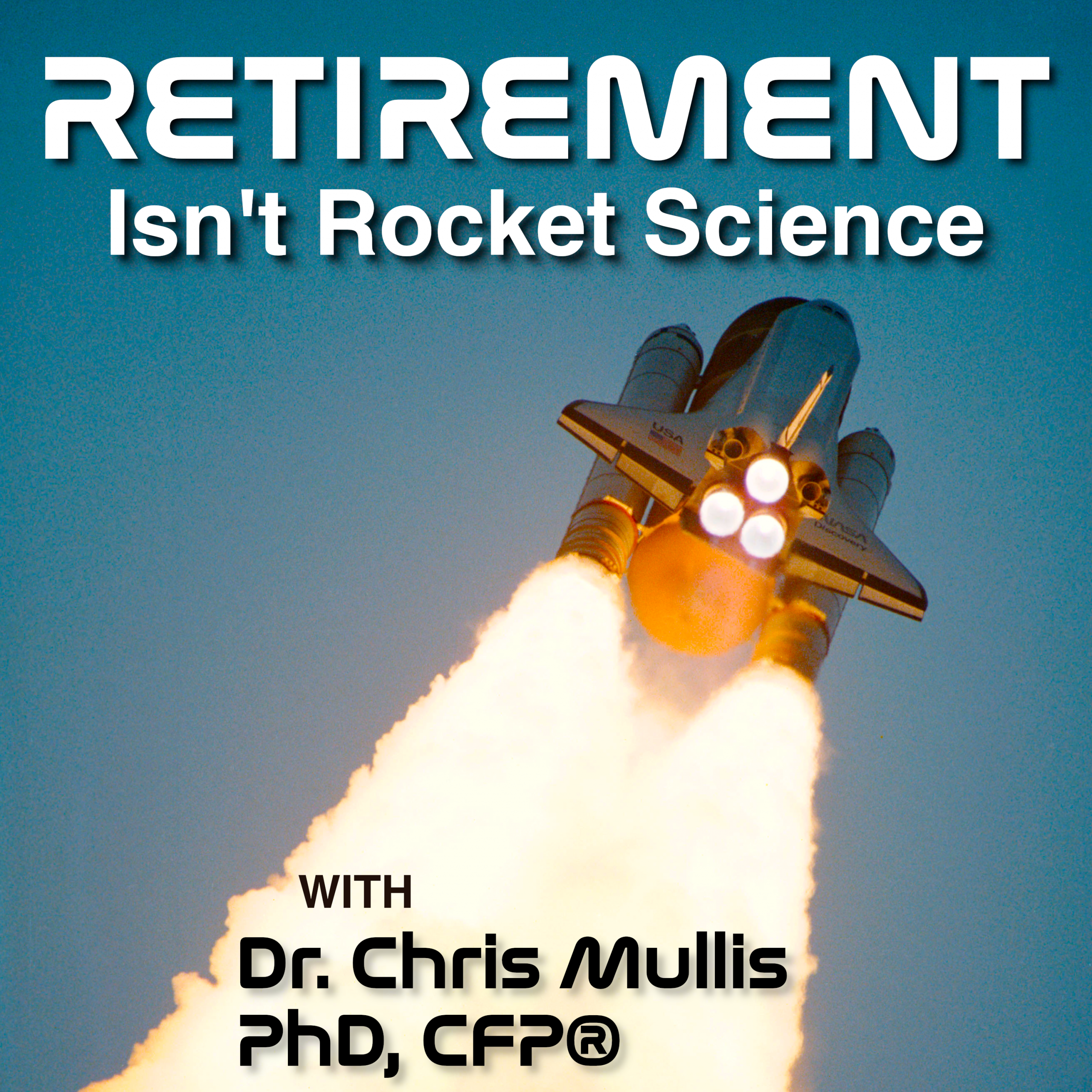Tax Moves to Make Before 2026

The retirement planning universe is shifting! With major tax & healthcare changes, the decisions you make now could save you thousands in taxes and healthcare costs. We’re breaking down the four most critical moves you must make before the end of 2025. In our listener question segment, we address if private equity is a smart move for your 401(k).
Retirement Big Picture
We look up for inspiration at the Tarantula Nebula, one of the largest and most magnificent star-forming regions in our galactic neighborhood. Discover why this cosmic powerhouse is like a natural, nearby laboratory for astronomers. Dr. Chris explains how studying its unique chemistry gives us a direct look at what the early universe was like, reminding us that even the most complex structures can be understood.


Sign Up for The Launch
The Launch is a weekly email from Dr. Chris and his team. It’s full of retirement tips, news, listener questions & more, straight from us to your inbox. Get smarter about retirement in just 5 minutes every week. Let’s go!
Episode Resources
- Seven Things You Should Do Before 2026 Because of One Big Beautiful Bill Changes
By Kimberly Lankford & Sandra Block
Episode Transcript
Introduction
Four things You should do before 2026, avoiding unnecessary complexity , and a cosmic tarantula caught by NASA’s web.
Are you ready?
Welcome back to Retirement Isn’t Rocket Science. I’m your host, Dr. Chris Mullis, a certified financial planner and former rocket scientist. My mission is to teach you proven easy to understand strategies to help you reduce taxes, invest smarter and ultimately make work optional.
In this week’s show, we examine four things that should be part of your year end tax planning. We answer your questions about private equity and we talk about a cosmic spider that’s anything but scary, the incredible tarantula nebula. Now let’s dive in.
Retirement Briefing Room
Welcome to the Retirement Briefing Room. This is where we huddle up to take a close look at retirement related research and news articles to think about how to integrate these into your plans to make your retirement even better.
Today’s topic is tax planning. To make this subject a little bit more tangible, I wanted to paint a picture of what tax planning can look like.
What does it look like at a retirement planning firm, for example. So I’m going to describe what tax planning looks like at my firm now. Taxes are a central component of our work. Almost every financial planning issue, whether it’s retirement investments. Cashflow insurance or estate planning has important tax considerations.
Tax planning is a year-round activity that permeates everything that we do. We help our clients hit the easy button during tax prep season, conduct an in-depth review of their returns both before and after submission, and ensure they understand exactly. How their tax bill actually works.
We collaborate closely with their accountants and help them effectively respond to any love letters from the IRS. We construct and continually update their tax projections both the current year and for their lifetime. We continually improve and update our knowledge of the complex and ever-changing landscape of retirement and tax law.
By the way, that’s the subject up to today’s feature to article. We execute multi-year Roth conversion plans to dramatically lower their looming tsunami of taxes in retirement while avoiding tax torpedoes like Medicare surcharges. Social security taxes, a CA premium tax credit losses, plus the new enhanced salt and senior deduction phase outs.
This is not an exhaustive account of all we do, but it does reflect our deep commitment to making sure our clients don’t get killed in taxes.
I hope this description of how we practice tax planning helps you better understand the concept and how it could be enhanced in your retirement planning as well.
Today’s insights come from the article Seven Things You Should Do Before 2026 because of the One Big Beautiful Bill Changes and it’s written by Kimberly Langford and Sandra Block and published in Kiplinger. This article offers a crucial pre 2026 checklist translating the complex provisions of the new one big, beautiful bill act that we’re gonna call oba.
Converts it into actionable steps for taxpayers. The OA was signed into law on the 4th of July and extends the popular income tax cuts from the 2017 Tax Cuts and Jobs Act preventing a major tax height. It also increases the federal estate tax exempt, and the core message here is significant tax changes are here, and you need to review your financial plan now to maximize the new benefits.
And sidestep. Any new pitfalls here we’re highlighting four aspects of OBA that definitely need to be factored into your year end planning.
Number one, there is a new bonus for older adults. The OBA introduced a temporary senior bonus deduction of $6,000 per person, or $12,000 for a married couple that’s available to any taxpayers aged 65 or older. This new deduction is in addition to the increased standard deduction and the existing age, 65 plus additional standard deduction.
Now this deduction is not permanent. It will be available only through 2028, and let me stress that it gives taxpayers four years to take advantage of this planning opportunity that it presents.
. For A married couple who are both 65 or older. This could mean an extra $12,000 in non-taxed income leading to significant savings, which could be over $2,600 a year for those in the 22% tax bracket.
Now here’s the tricky part that you need to watch. This bonus deduction begins to phase out for couples with a modified adjusted gross income over $150,000, and disappears completely when that income is above $250,000.
Now this is a prime opportunity to be strategic with your tax and income planning. If you’re close to those income limits, we’ll want to be careful with Roth conversions, which do increase your taxable income . You might want to spread those conversions over several years.
Or even complete them before you turn age 65. To avoid the phase out trap, we could also use qualified charitable distributions, qds from your IRA if you’re age 70 and a half or older, to reduce your taxable income while supporting the causes you care about. This planning helps you preserve the deduction and keep your financial trajectory smooth.
But do keep in mind, it may be more beneficial to sacrifice this extra deduction if your multi-year tax plan shows your Roth conversions are far more valuable than the current year deduction, which could easily be the case if you have significant assets in your pre-tax IRA.
I encourage you to work up your tax focused advisor or your CPA to forecast your 2025 Magi. That is your modified adjusted gross income. Think through if you should adjust any of your other tax strategies such as Roth conversion, timing, IRA withdrawals or charitable giving through qds to keep below the bonus deduction, phase out threshold if you’re age 65 or older.
Number two in the OBA is a bigger break for homeowners. For our listeners who own homes, especially in high tax states, the OBA gives a substantial tax break that could affect your 2025 tax bill. The cap on the deduction of state and local taxes, that’s called salt state and local taxes is jumping from $10,000 to $40,000. For taxpayers who itemize, that could be a huge win. If you pay significant property or state taxes, this could put thousands of dollars back in your pocket.
However, just like the enhanced senior deduction, the higher salt cap also has a high income phase out that’s starting for those with a modified adjusted gross income above $500,000 for joint filers. If you’re near that limit, this tax break is also a massive incentive. To manage your modified adjusted gross income
The number three aspect of OBA is new strategies for charitable contributions. We know that many of our listeners are kindhearted people who care deeply about their communities. The OBA is changing the tax rules around charitable giving and two main ways, and the timing of your gifts could be critical first, starting in 2026.
Those of you who don’t itemize can take a small deduction for cash contributions. Up to a thousand dollars for single filers and $2,000 for couples. This is a nice little break. Second For those who do itemize, a new limit is coming in 2026. Your deduction will only count for contributions that exceed half a percent of your adjusted gross income. This new floor can shrink the value of your charitable deductions .
Now a potential way to manage this opportunity in a tax and estate planning sense is a two-pronged strategy. If you usually itemize, it makes sense to accelerate your 2026 contributions into 2025 to avoid that new half a percent floor. That will come in 2026. And then number two, if you’re a significant donor using a donor-advised fund is an excellent tool. You’ll make a large lump sum contribution and a high income. High deduction year, like 2025, getting the immediate tax break, and then grant the money to the charities that you support over time.
This works perfectly with the bunching strategy that’s often discussed for maximizing your giving and maximizing your tax savings.
The number four aspect of the OBA to put on your radar is changes to the health insurance marketplace and the enhanced subsidies that are now scheduled to expire. For our listeners who rely on the Affordable Care Act. The a CA health insurance marketplace for coverage, especially those that have made it to retirement early and are just counting their time until they qualify for Medicare at age 65.
This needs your attention. The most consequential news is that the enhanced premium subsidies are set to expire at the end of 2025.
This means that starting in 2026, the size of those subsidies will shrink, and a lot of people will lose them entirely , including anyone earning more than 400% of the federal poverty level. For 2026 plans, that threshold is only about $62,600 for a single person, or $84,600 for a couple. This is huge for your income and tax planning.
As financial planners, we’ve been using the enhanced subsidies as a runway to do strategic Roth conversions in retirement, taking money from tax deferred accounts and moving them to tax free Roths while keeping your modified adjusted gross income. Low enough to qualify for those big healthcare subsidies, but the game is changing.
If you’ve been doing large Roth conversions, the extra income from those conversions in 2026 could completely eliminate your healthcare subsidy, resulting in a much larger health insurance bill before 2026. You might want to accelerate your Roth conversions in late 2025 while the enhanced subsidies are still around after 2025, you’ll likely need to reduce the size of your annual Roth conversions.
To keep your modified adjusted gross income below the new lower subsidy cutoff. Now, this is a delicate balance act between the tax rates and healthcare costs where a certified financial planner can provide some deep insight. If you’re using the a CA marketplace for insurance, work with your advisor now to model your 2025 income and maximize your Roth conversions before the enhanced subsidies expire, and the income cap drops in 2026.
Now in conclusion, navigating these tax law changes. May feel like rocket science at first brush, but take a step back. The key is to be proactive and take a multi-year lens to minimize your lifetime tax bill. And of course, this allows you to spend more money in retirement while paying less in taxes.
We thank the authors Kimberly Langford and Sandra Block for this insightful and action inspiring retirement article to supercharge your year end tax planning. If you’re interested in learning more, a link to the Kiplinger article is in today’s show notes that you’ll find in our weekly newsletter called the Launch.
You can sign up for the launch at retirement isn’t rocket science.com now let’s head over to mission Control to answer your financial and retirement questions.
Ask Mission Control
In this week’s ask Mission Control our listener question regards private equity. He writes, I recently heard that my 401k plan may include private equity in the very near future, should that be part of my retirement portfolio. Now we’ve seen a lot of buzz about private equity or pe, and thanks to a recent executive order from the president, it’s making its way towards 401k plans. First, let’s simplify what is private equity.
Now you can think of it like a giant venture capital fund that buys companies that aren’t traded on the public stock exchange. They’re private. These could be startups or mature businesses being taken over, or companies being revamped for a quick sale. The goal is to dramatically increase the company’s value and then sell it in a few years for a huge profit.
Now why all the excitement historically private equity has has sometimes, in limited circumstances, outperformed the public stock market. One of the challenges here is it also dramatically underperforms the public stock market on a consistent basis as well. So you have a few private equity funds that have had grand slams, but they are the exception to the rule, and that can be particularly dangerous.
But taking a step back, there are three big concerns that make us approach this with extreme caution. Those are liquidity, transparency, and fees. So let’s break down each of those.
Number one, liquidity. The freeze button. You know, our listeners, our prudent super savers, right? That have. Done a tremendous amount of effort to build up a nest egg, and they are approaching that time life where it’s time to live off those savings and have a great retirement. This is the income phase of retirement.
You know, they need that money to be accessible. Private equity is the opposite of liquid and accessibility. It’s like pouring concrete instead of water. When an investment manager puts money in a private equity investment, it’s typically locked up for seven to 10 years or more. Now if the market tanks and you need to adjust your investment portfolio or tap that money for an unexpected expense, you can’t simply click a button and sell your private equity position.
Number two, transparency. The black box public stocks are highly regulated with transparent pricing and regular reporting. Private equity is much more of a black box. The valuations of the intrinsic investments within the private investment vehicle aren’t updated daily, and the way they calculate those returns can be complex.
Very oftentimes confusing for a prudent investor. You lose a lot of visibility that helps you feel confident about your financial trajectory. And number three, fees are the drag private equity funds are known for charging significantly higher fees than low cost tax efficient exchange traded funds or mutual funds.
Even if the fund performs well, those high fees will act as a major drag on your net returns as a certified financial planner. 24 7 fiduciary. My job as a retirement planner is to find the most cost effective and efficient way to help the families that we serve do well with their investments, so that they’re able to spend more in retirement and pay less in fees and taxes.
High cost complex funds often fail that test.
One thing to take a step back and reflect on is that complexity naturally comes to us as we age and as we accumulate more money, we don’t have to, nor should we seek out additional complexity. It naturally comes to us. That’s why I recommend that you lean towards simplicity where you have agency.
Private equity is an unneeded complexity and an unneeded risk for the vast majority of people building a resilient retirement plan. Hey, thanks again to our listener for that fantastic question. If you’ve got your own question that you’d like us to answer on the show, head over to Retirement isn’t Rocket science and click Ask a Question or even better, you can skip to the front of the line by calling Mission Control on our hotline at 704-234-6550 and record your audio message.
Again, that’s 704-234-6550. Now let’s broaden our perspective and explore another amazing corner of our universe.
Retirement Big Picture
Welcome to the Retirement Big Picture part of our show. This is where we look up and look out to expand our appreciation and understanding of our beautiful universe. Today’s featured object comes courtesy of Dr. Neil de Grace Tyson. Dr. Tyson is a renowned American astrophysicist. Author, an influential science communicator who serves as the director of the Hayden Planetarium in New York City.
Dr. Tyson spoke recently here in Charlotte on the search for life in the universe, and his opening slide featured the Tarantula Nebula.
This is one of the most magnificent and scientifically productive objects in our galactic neighborhood. Why is this vast cosmic cloud, formerly known as 30 Doradus? So beautiful and exciting. It’s simply the largest and brightest star forming region in the local group of galaxies. That’s the cosmic cluster that includes our very own Milky Way galaxy, located about 160,000 light years away, and a satellite galaxy called the Large Magellan Cloud.
The Tarantula Nebula is an absolute stellar powerhouse. Now just a side note on the Large Magellanic Cloud, it’s one of the dwarf galaxies that goes around our galaxy. And if you’re like many of our North American listeners, you might be saying, why have I never seen that? Well, the answer is relatively simple.
It’s in the southern sky. You need to live south of the equator in general to see it. So if you ever have an occasion to travel. In the Southern Hemisphere. Make sure you go out at night and try to see the Large Magellanic Cloud, and if you have a pair of binoculars, even better. Now, back to the tarantula.
First, let’s talk about its beauty. Its iconic appearance is one of vivid swirling clouds of gas and dust. A vast, intricate, stellar nursery. When you look at images from the Hubble Space Telescope. The webspace telescope. You see these dramatic filaments that give it its spider like nickname.
The brilliant pale blue light at its heart comes from an astonishing concentration of massive young stars. These aren’t just any old stars. These are some of the hottest, most massive stars known to astronomers with some exceeding 100 times the mass of our sun. The intense radiation and powerful winds from these stellar giants literally carve out giant cavities in the surrounding gas and dust sculpting the incredible structures we see.
Now for the excitement, the Torrential Nebula is a natural, nearby and accessible laboratory for testing out our theories of star formation and stellar evolution. What makes it truly special is its chemical composition.
It’s different from most star forming regions in the Milky Way. Instead, its chemistry is a close match to the gigantic star forming regions that existed during the universe’s Cosmic noon, A period billions of years ago when star formation was at its absolute peak by studying the torrential nebula in detail, particularly with the new eye of the James Webb space telescope.
We’re not just looking at a beautiful site, we’re getting a direct closeup look at what the early universe was like. The data collected by missions like Hubble and more recently, JWST are helping us untangle the complex physics of how massive stars are born, live and die. A cycle that enriches the universe with heavy elements necessary for things like planets and eventually even retirement planners.
Conclusion
You’ll find a stunning image of the Tarantula Nebula Show notes in today’s featured retirement article in our weekly newsletter. The launch. Sign up For the launch at retirement isn’t rocket science.com. So what’s your next step? I challenge you to take just one idea from today’s show and put it into practice this week to help you on your journey to worry less and retire more. Until Next time, I’m Dr. Chris reminding you retirement isn’t rocket science.
Credits
We thank the National Aeronautics and Space Administration for providing the radio communication between the space shuttle astronauts and the flight controllers.
Disclaimer
This show is for informational and entertainment purposes only. It is not specific tax, legal or investment advice.
Before considering acting on anything you hear in this show, first consult your own tax, legal or financial advisor.


